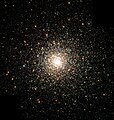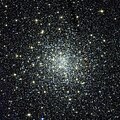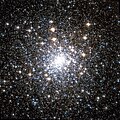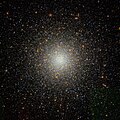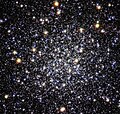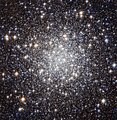Shapley-Sawyer-Konzentrationsklasse
Die Shapley-Sawyer-Konzentrationsklassen bilden ein qualitatives Klassifizierungssystem, mit dem Harlow Shapley und seine Doktorandin Helen Sawyer Hogg ab 1927 Kugelsternhaufen auf fotografischen Aufnahmen nach ihrer scheinbaren Konzentration ordneten.[1]
Die Skala reicht von eins bis zwölf, wobei römische Zahlen verwendet werden:
- Die am stärksten konzentrierten Haufen werden der Klasse I zugeordnet, z. B. M75.
- Mit abnehmender Konzentration nimmt die Klassennummer zu und reicht bis zur Klasse XII, z. B. bei NGC 4372.
- Die Klassengrenzen wurden von Shapley und Sawyer Hogg so gesetzt, dass die zwölf Klassen jeweils etwa die gleiche Anzahl der 1927 bekannten 95 Kugelsternhaufen enthielten.
Der hellste Haufen am Nordhimmel, Messier 13, gehört zur Klasse V.
Die Konzentrationsklassen werden heute beispielsweise von Amateurastronomen noch verwendet, um den zu erwartenden optischen Eindruck bei der Beobachtung von Kugelsternhaufen zu beschreiben. Für wissenschaftliche Zwecke erhalten quantitative Maße zur Beschreibung der Struktur der Haufen den Vorzug, wie man sie etwa durch Anpassung parametrischer Modelle an die gemessenen Flächenhelligkeitsprofile erhält.[2]
Klassen
| Klasse | Beschreibung | Beispiel |
|---|---|---|
| I | Hohe Konzentration zur Mitte hin | |
| II | Dichte zentrale Konzentration | |
| III | Starker innerer Kern aus Sterne | |
| IV | Mittlere reichhaltige Konzentrationen |
|
| V | Mittlere Konzentrationen |
|
| VI | Mittlere milde Konzentration | |
| VII | Mittlere lockere Konzentration | |
| VIII | Eher locker zur Mitte hin konzentriert |
|
| IX | Locker zur Mitte hin | |
| X | Lose | |
| XI | Zur Mitte hin sehr locker | |
| XII | Fast keine Konzentration auf die Mitte |
|
Einzelnachweise
- ↑ Harlow Shapley, Helen B. Sawyer: A Classification of Globular Clusters. In: Harvard College Observatory Bulletin. Band 849, 1927, S. 11–14, bibcode:1927BHarO.849...11S.
- ↑ James Binney, Michael Merrifield: Galactic Astronomy. Princeton University Press, 1998, ISBN 0-691-02565-7.
- ↑ Jeff Burton: Shapley–Sawyer Globular Cluster Concentration Class. In: astrogeek.org. Jeff Burton, 26. Juli 2011, archiviert vom am 22. März 2012; abgerufen am 1. Januar 2024 (englisch).
- ↑ Concentration Classes of Globular Clusters. In: messier.seds.org. SEDS, 19. Februar 2014, abgerufen am 1. Januar 2024 (englisch).
- ↑ Harlow Shapley: Star Clusters. In: Harvard-College-Observatorium (Hrsg.): Harvard Observatory Monographs. Band 2. New York 1. Januar 1930, S. 11–14, bibcode:1930HarMo...2.....S (englisch, eingeschränkte Vorschau in der Google-Buchsuche [abgerufen am 1. Januar 2024]).
Auf dieser Seite verwendete Medien
Autor/Urheber: HST / Fabian RRRR (talk), Lizenz: CC BY-SA 3.0
Color rendering is done by by Aladin-software (2000A&AS..143...33B.)
(c) NASA & ESA, CC BY 4.0
This image from the NASA/ESA Hubble Space Telescope shows the globular cluster Messier 9. Hubble’s image resolves stars right into the centre of the cluster, and clearly shows they have different colours. Redder colours signify lower surface temperatures, while blue stars are extremely hot.
Autor/Urheber: Sloan Digital Sky Survey, Lizenz: CC BY 4.0

Angle of view: 12' x 12' (0.3515625" per pixel), north is up.
Details on the image processing pipeline: https://www.sdss.org/dr14/imaging/jpg-images-on-skyserver/en:Messier 54 globular cluster by en:Hubble Space Telescope; 3.5′ view
Autor/Urheber: HST / Fabian RRRR (talk), Lizenz: CC BY-SA 3.0
Color rendering is done by by Aladin-software (2000A&AS..143...33B.)
The dazzling stars in Messier 15 look fresh and new in this image from the NASA/Hubble Space Telescope, but they are actually all roughly 13 billion years old, making them some of the most ancient objects in the Universe. Unlike another recent Hubble Picture of the Week, which featured the unusually sparse cluster Palomar 1, Messier 15 is rich and bright despite its age.
Messier 15 is a globular cluster — a spherical conglomeration of old stars that formed together from the same cloud of gas, found in the outer reaches of the Milky Way in a region known as the halo and orbiting the Galactic Centre. This globular lies about 35 000 light-years from the Earth, in the constellation of Pegasus (The Flying Horse).
Messier 15 is one of the densest globulars known, with the vast majority of the cluster’s mass concentrated in the core. Astronomers think that particularly dense globulars, like this one, underwent a process called core collapse, in which gravitational interactions between stars led to many members of the cluster migrating towards the centre.
Messier 15 is also the first globular cluster known to harbour a planetary nebula, and it is still one of only four globulars known to do so. The planetary nebula, called Pease 1, can be seen in this image as a small blue blob to the lower left of the globular’s core.
This picture was put together from images taken with the Wide Field Channel of Hubble's Advanced Camera for Surveys. Images through yellow/orange (F606W, coloured blue) and near-infrared (F814W, coloured red) filters were combined. The total exposure times were 535 s and 615 s respectively and the field of view is 3.4 arcminutes across.The high concentration of stars within globular clusters, like Messier 12, shown here in an image from the NASA/ESA Hubble Space Telescope, makes them beautiful photographic targets. But the cramped living quarters in these clusters also makes them home to exotic binary star systems where two stars are locked in tight orbits around each other and matter from one is gobbled up by its companion, releasing X-rays. It is thought that such X-ray binaries form from very close encounters between stars in crowded regions, such as globular clusters, and even though Messier 12 is fairly diffuse by globular cluster standards, such X-ray sources have been spotted there.
Astronomers have also discovered that Messier 12 is home to far fewer low-mass stars than was previously expected (eso0604). In a recent study, astronomers used the European Southern Observatory’s Very Large Telescope at Cerro Paranal, Chile, to measure the brightness and colours of more than 16 000 of the globular’s 200 000 stars. They speculate that nearly one million low-mass stars have been ripped away from Messier 12 as the globular has passed through the densest regions of the Milky Way during its orbit around the galactic centre.
It seems that the serenity of this view of Messier 12 is misleading and the object has had a violent and disturbed past.
Messier 12 lies about 23 000 light-years away in the constellation of Ophiuchus (The Serpent Bearer). This image was taken using the Wide Field Channel of Hubble’s Advanced Camera for Surveys. The colour image was created from exposures through a blue filter (F435W, coloured blue), a red filter (F625W, coloured green) and a filter that passes near-infrared light (F814W coloured red). The total exposure times were 1360 s, 200 s and 364 s, respectively. The field of view is about 3.2 x 3.1 arcminutes.Autor/Urheber: ESA/Hubble & NASA, Lizenz: CC BY 3.0
The NASA/ESA Hubble Space Telescope has captured a crowd of stars that looks rather like a stadium darkened before a show, lit only by the flashbulbs of the audience’s cameras. Yet the many stars of this object, known as Messier 107, are not a fleeting phenomenon, at least by human reckoning of time — these ancient stars have gleamed for many billions of years.
Messier 107 is one of more than 150 globular star clusters found around the disc of the Milky Way galaxy. These spherical collections each contain hundreds of thousands of extremely old stars and are among the oldest objects in the Milky Way. The origin of globular clusters and their impact on galactic evolution remains somewhat unclear, so astronomers continue to study them through pictures such as this one obtained by Hubble.
As globular clusters go, Messier 107 is not particularly dense. Visually comparing its appearance to other globular clusters, such as Messier 53 or Messier 54 reveals that the stars within Messier 107 are not packed as tightly, thereby making its members more distinct like individual fans in a stadium's stands.
Messier 107 can be found in the constellation of Ophiuchus (The Serpent Bearer) and is located about 20 000 light-years from the Solar System.
French astronomer Pierre Méchain first noted the object in 1782, and British astronomer William Herschel documented it independently a year later. A Canadian astronomer, Helen Sawyer Hogg, added Messier 107 to Charles Messier's famous astronomical catalogue in 1947.
This picture was obtained with the Wide Field Camera of Hubble’s Advanced Camera for Surveys. The field of view is approximately 3.4 by 3.4 arcminutes.Autor/Urheber: Till Credner und Sven Kohle, Observatorium Hoher List, Lizenz: CC BY-SA 2.0 de
Kugelsternhaufen M 10
en:Messier 30 globular cluster by en:Hubble Space Telescope; 3.5′ view
Autor/Urheber: ESO. Acknowledgement: ESO Imaging Survey, Lizenz: CC BY 3.0
This image from the Wide Field Imager attached to the MPG/ESO 2.2-metre telescope at ESO’s La Silla Observatory shows the spectacular globular star cluster Messier 4. This great ball of ancient stars is one of the closest of such stellar systems to the Earth and appears in the constellation of Scorpius (The Scorpion) close to the bright red star Antares.
Autor/Urheber: Sloan Digital Sky Survey, Lizenz: CC BY 4.0

Angle of view: 24' x 24' (0.3515625" per pixel), north is up.
Details on the image processing pipeline: https://www.sdss.org/dr14/imaging/jpg-images-on-skyserver/Autor/Urheber: HST / Fabian RRRR (talk), Lizenz: CC BY-SA 3.0
Color rendering is done by by Aladin-software (2000A&AS..143...33B.)
Messier 28
M28 is a globular cluster located 17,900 light-years away from Earth in the constellation Sagittarius. It was discovered by Charles Messier in 1764. With an apparent magnitude of 7.7, the cluster appears as a faint patch of light through a pair of binoculars. Large telescopes can resolve its individual stars more effectively. The month of August is the best time to view M28.
The cluster is most notable for being the first of its kind known to contain a millisecond pulsar: PSR B1821–24. This dense neutron star rotates rapidly (about once every three milliseconds) and emits radiation from its poles, which sweeps past Earth as the star spins, much like a beam of light from a lighthouse. This makes it appear to be pulsing to observers on Earth. PSR B1821–24 was discovered in 1986 using a radio telescope in England called the Lovell Telescope.
This Hubble image of M28’s center was assembled from observations taken at visible, infrared and ultraviolet wavelengths.(c) ESA/Hubble & NASA, CC BY 4.0
In this image, the NASA/ESA Hubble Space Telescope has captured the brilliance of the compact centre of Messier 70, a globular cluster. Quarters are always tight in globular clusters, where the mutual hold of gravity binds together hundreds of thousands of stars in a small region of space. Having this many shining stars piled on top of one another from our perspective makes globular clusters a popular target for amateur skywatchers and scientists alike. Messier 70 offers a special case because it has undergone what is known as a core collapse. In these clusters, even more stars squeeze into the object's core than on average, such that the brightness of the cluster increases steadily towards its centre.
The legions of stars in a globular cluster orbit about a shared centre of gravity. Some stars maintain relatively circular orbits, while others loop out into the cluster's fringes. As the stars interact with each other over time, lighter stars tend to pick up speed and migrate out toward the cluster's edges, while the heavier stars slow and congregate in orbits toward the centre. This huddling effect produces the denser, brighter centres characteristic of core-collapsed clusters. About a fifth of the more than 150 globular clusters in the Milky Way have undergone a core collapse.
Although many globular clusters call the galaxy's edges home, Messier 70 orbits close to the Milky Way's centre, around 30 000 light-years away from the Solar System. It is remarkable that Messier 70 has held together so well, given the strong gravitational pull of the Milky Way's hub.
Messier 70 is only about 68 light-years in diameter and can be seen, albeit very faintly, with binoculars in dark skies in the constellation of Sagittarius (The Archer). French astronomer Charles Messier documented the object in 1780 as the seventieth entry in his famous astronomical catalogue.
This picture was obtained with the Wide Field Camera of Hubble’s Advanced Camera for Surveys. The field of view is around 3.3 by 3.3 arcminutes.
Colours & filters Band Wavelength Telescope Infrared I 814 nm Hubble Space Telescope ACS Optical Pseudogreen (V+I) Hubble Space Telescope ACS Optical V 606 nm Hubble Space Telescope ACS.
Messier 68 globular cluster by Hubble Space Telescope; 3.32′ view
Autor/Urheber: Giuseppe Donatiello from Oria (Brindisi), Italy, Lizenz: CC0
Messier 13 - The Hercules Globular Cluster Credit: ZTF, Giuseppe Donatiello
J2000 RA 16h 41m 41.24s Dec +36° 27′ 35.5″ Messier 13 (M13), or NGC 6205, is a globular cluster of about 300,000 stars in Hercules, discovered by Edmond Halley in 1714, and catalogued by Charles Messier on June 1, 1764. M13 is about 145 light-years in diameter and at 25,100 light-years away from Earth.
The Arecibo message of 1974, which contained encoded information about the human race, DNA, atomic numbers, Earth's position and other information, was beamed from the Arecibo Observatory radio telescope towards M13 as an experiment in contacting potential extraterrestrial civilizations in the cluster.(c) ESA/Hubble, CC BY 4.0
Comet or cluster?
Most globular clusters are almost perfectly spherical collections of stars — but Messier 62 breaks the mould. The 12-billion-year-old cluster is distorted, and stretches out on one side to form a comet-like shape with a bright head and extended tail. As one of the closest globular clusters to the centre of our galaxy, Messier 62 is likely affected by strong tidal forces that displace many of its stars, resulting in this unusual shape.
When globular clusters form, they tend to be somewhat denser towards the centre. The more massive the cluster, the denser the centre is likely to be. With a mass with almost a million times that of the Sun, Messier 62 is one of the densest of them all. With so many stars at the centre, interactions and mergers occur regularly. Huge stars form and run out of fuel quickly, exploding violently and their remains collapse to form white dwarfs, neutron stars and even black holes!
For many years, it was believed that any black holes that form in a globular cluster would quickly be kicked out due to the violent interactions taking place there. However, in 2013, a black hole was discovered in Messier 62 — the first ever to be found in a Milky Way globular cluster, giving astronomers a whole new hunting ground for these mysterious objects.
This view comprises ultraviolet and visible light gathered by the NASA/ESA Hubble Space Telescope’s Advanced Camera for Surveys.
Credit:
ESA/Hubble & NASA, S. Anderson et al.
Coordinates Position (RA): 17 1 9.44 Position (Dec): -30° 6' 37.91" Field of view: 2.70 x 2.77 arcminutes Orientation: North is 2.9° right of vertical
Colours & filters Band Wavelength Telescope Optical C 390 nm Hubble Space Telescope WFC3 Optical B 435 nm Hubble Space Telescope ACS Optical NII 658 nm Hubble Space Telescope ACS Optical r 625 nm Hubble Space Telescope ACS.
Autor/Urheber: Sloan Digital Sky Survey, Lizenz: CC BY 4.0

Angle of view: 12' x 12' (0.3515625" per pixel), north is up.
Details on the image processing pipeline: https://www.sdss.org/dr14/imaging/jpg-images-on-skyserver/Globular cluster en:Palomar 12 by Hubble Space Telescope 3.36′ view, North is 27° counterclockwise
Autor/Urheber: NASA & ESA. Acknowledgement: Gilles Chapdelaine, Lizenz: CC BY 3.0
The NASA/ESA Hubble Space Telescope has produced this beautiful image of the globular cluster Messier 56 (also known as M 56 or NGC 6779), which is located about 33 000 light years away from the Earth in the constellation of Lyra (The Lyre). The cluster is composed of a large number of stars, tightly bound to each other by gravity.
However, this was not known when Charles Messier first observed it in January 1779. He described Messier 56 as “a nebula without stars”, like most globular clusters that he discovered — his telescope was not powerful enough to individually resolve any of the stars visible here, making it look like a fuzzy ball through his telescope’s eyepiece. We clearly see from Hubble’s image how the development of technology over the years has helped our understanding of astronomical objects.
Astronomers typically infer important properties of globular clusters by looking at the light of their constituent stars. But they have to be very careful when they observe objects like Messier 56, which is located close to the Galactic plane. This region is crowded by “field-stars”, in other words, stars in the Milky Way that happen to lie in the same direction but do not belong to the cluster. These objects can contaminate the light, and hence undermine the conclusions reached by astronomers.
A tool often used by scientists for studying stellar clusters is the colour-magnitude (or Hertzsprung-Russell) diagram. This chart compares the brightness and colour of stars – which in turn, tells scientists what the surface temperature of a star is.
By comparing high quality observations taken with the Hubble Space Telescope with results from the standard theory of stellar evolution, astronomers can characterise the properties of a cluster. In the case of Messier 56, this includes its age, which at 13 billion years is approximately three times the age of the Sun. Furthermore, they have also been able to study the chemical composition of Messier 56. The cluster has relatively few elements heavier than hydrogen and helium, typically a sign of stars that were born early in the Universe’s history, before many of the elements in existence today were formed in significant quantities.
Astronomers have found that the majority of clusters with this type of chemical makeup lie along a plane in the Milky Way’s halo. This suggests that such clusters were captured from a satellite galaxy, rather than being the oldest members of the Milky Way's globular cluster system as had been previously thought.
This image consists of visible and near-infrared exposures from Hubble’s Advanced Camera for Surveys. The field of view is approximately 3.3 by 3.3 arcminutes.
A version of this image was entered into the Hubble’s Hidden Treasures Image Processing Competition by contestant Gilles Chapdelaine. Hidden Treasures is an initiative to invite astronomy enthusiasts to search the Hubble archive for stunning images that have never been seen by the general public. The competition has now closed and the results will be published soon.Messier 19, center imaged by Hubble Space Telescope
This stellar swarm is M80 (NGC 6093), one of the densest of the 147 known globular star clusters in the Milky Way galaxy. Located about 28,000 light-years from Earth, M80 contains hundreds of thousands of stars, all held together by their mutual gravitational attraction. Globular clusters are particularly useful for studying stellar evolution, since all of the stars in the cluster have the same age (about 12 billion years), but cover a range of stellar masses. Every star visible in this image is either more highly evolved than, or in a few rare cases more massive than, our own Sun. Especially obvious are the bright red giants, which are stars similar to the Sun in mass that are nearing the ends of their lives.


